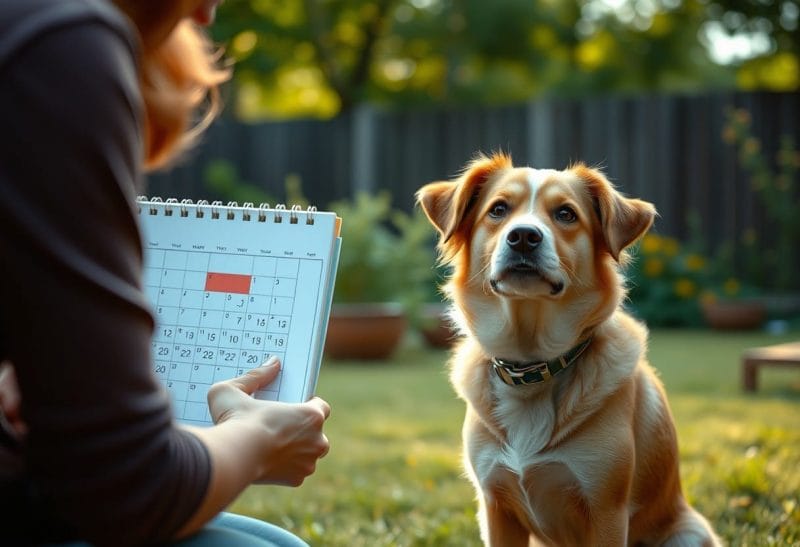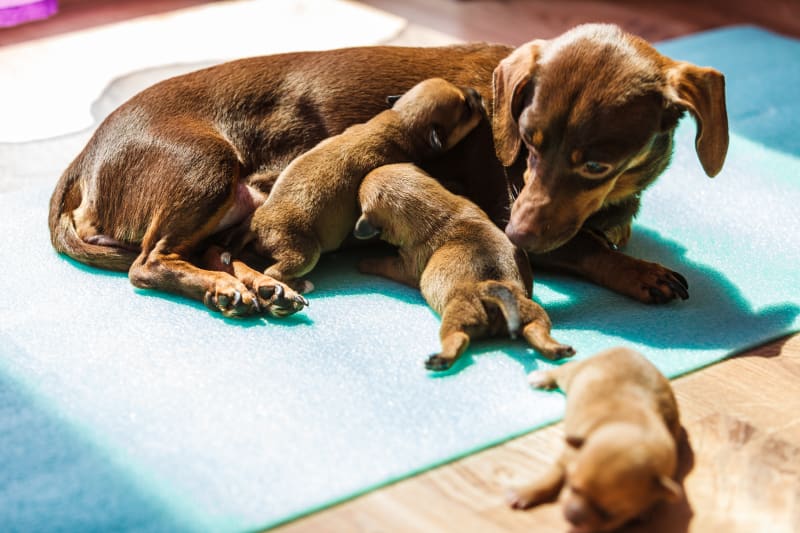Prevention is the key when it comes to avoiding unwanted pregnancies in female dogs. Understanding your dog’s reproductive cycle and implementing effective strategies can help ensure she remains free from the challenges of pregnancy. In this guide, you will learn practical tips on managing her health and behavior, as well as options like spaying that can permanently prevent pregnancy. With the right approach, you can maintain your dog’s well-being and avoid the responsibilities that come with unplanned litters.
Key Takeaways:
- Spaying your female dog is the most effective way to prevent unwanted pregnancies.
- Supervision during her heat cycle can help avoid accidental mating with male dogs.
- Separation from unneutered males is crucial during her fertile period to reduce the risk of pregnancy.
Understanding Female Dog Reproduction
The reproductive cycle of a female dog is important for you to comprehend if you want to avoid unplanned pregnancies. Female dogs typically experience their first heat cycle between six months and two years of age, depending on the breed. This cycle consists of four distinct phases: proestrus, estrus, diestrus, and anestrus. During the heat phase, a female dog is fertile and more receptive to mating. By knowing these phases, you can better manage your dog’s reproductive health.
Canine Reproductive Cycle
Reproductive cycles in female dogs are driven by hormonal changes that regulate their readiness for mating and potential pregnancy. Each cycle lasts approximately six months, but this can vary between individual dogs and breeds. By monitoring your dog’s cycle, you can determine the best times to prevent accidental mating and control her reproductive health effectively.
Signs of Heat in Female Dogs
Understanding the signs of heat in female dogs is crucial in preventing unwanted pregnancies. You should be on the lookout for behavioral changes and physical symptoms that indicate your dog is in heat. These can include increased urination, a swollen vulva, and a noticeable discharge. During this period, your dog’s personality may also change, making her more affectionate or restless.
Heat cycles can last anywhere from two to three weeks, and female dogs may display unique behaviors during this time. You might notice your dog being more vocal, seeking attention, or trying to escape. Additionally, male dogs may be drawn to her scent, increasing the risk of unplanned mating. Being vigilant during these signs is vital to manage your dog’s reproductive health effectively.
Effective Prevention Methods
Even if you love your female dog, avoiding her pregnancy should be a priority to prevent unwanted litters and health complications. Understanding the most reliable and temporary solutions can help you take the best approach to manage your dog’s reproductive health.
Spaying: The Most Reliable Option
Now, spaying your female dog is the most effective and reliable method to prevent pregnancy. This surgical procedure not only eliminates the possibility of unexpected litters but also reduces the risk of certain cancers and health issues related to the reproductive system.
Temporary Solutions: Birth Control Pills
Effective birth control pills can be a temporary solution to prevent unplanned pregnancies in female dogs. These hormonal medications can regulate your dog’s cycle, allowing you to manage her heat periods more effectively.
A combination of estrogen and progesterone, these pills work by suppressing the heat cycle and preventing ovulation. However, be aware of the potential side effects and consult your veterinarian to determine the best course of action and discuss any risks involved with long-term use of these medications.
Behavioral Modifications During Heat
With careful planning, you can implement behavioral modifications during your dog’s heat cycle to avoid accidental mating. Keeping her away from male dogs and monitoring her closely is vital for ensuring her well-being during this sensitive time.
The implementation of consistent routines, such as increased supervision and restricting access to outdoor areas where male dogs may roam, will help you manage your female dog’s behavior effectively. It’s crucial to prepare for her heat cycles, as these changes can be detrimental if not addressed adequately.

Essential Tips for Dog Owners
Unlike many pet owners believe, preventing female dog pregnancy requires a proactive approach. Here are some necessary tips to help you avoid unintended litters:
- Consider spaying your female dog to eliminate the risk of unwanted pregnancies.
- Keep your dog securely indoors during her heat cycle.
- Limit her exposure to male dogs while she is in heat.
- Use dog diapers to minimize the risk of attracting male dogs.
- Educate yourself about your dog’s reproductive cycle.
Knowing these tips can give you peace of mind and contribute to responsible pet ownership. For further guidance, check out How to Prevent Your Dog From Getting Pregnant.
Monitoring and Managing Heat Cycles
With careful monitoring of your dog’s heat cycles, you can significantly reduce the chances of accidental breeding. Understanding the signs that your dog is in heat—such as swelling, bleeding, or behavioral changes—allows you to take appropriate measures to keep her away from male dogs. Tracking her cycle will help you be prepared and manage her surroundings effectively.
Preventing Unwanted Breeding Scenarios
While it may seem impossible to completely avoid every unwanted breeding scenario, taking precautions can greatly minimize the risks. Always supervise your dog when she is outside, especially during her heat cycle, and be vigilant about closing any gaps in your yard that could allow a male dog to enter.
For instance, ensure that your fence is secure and that any outside time is carefully monitored. If you’re visiting parks or communal areas, keep her leashed and concentrate on keeping a safe distance from other dogs. Controlling the environment where your dog spends her time is crucial in avoiding unexpected encounters.
Consulting with Veterinarians
Consulting with veterinarians can provide you with valuable insights into responsible breeding practices and care for your dog. Your vet can guide you on the best times to spay, the health benefits of spaying, and when to track your dog’s heat cycle.
Cycles can vary between individual dogs, and having a conversation with your veterinarian will help you understand your pet’s specific needs. They may recommend additional strategies or timing for surgery and help you plan a health and wellness schedule for your dog.
Factors to Consider
For dog owners looking to avoid female dog pregnancy, it’s vital to consider a variety of factors that can influence your pet’s reproductive health. Here are some key points to keep in mind:
- Adequate understanding of your dog’s reproductive cycle.
- Importance of spaying and neutering.
- Regular veterinary check-ups.
- Monitoring social interactions with other dogs.
- Utilizing birth control options if necessary, such as those discussed in Birth Control for Dogs.
After weighing these factors, you can make informed decisions about your dog’s reproductive health.
Age and Health of the Dog
Even if your dog is at a healthy age, it’s crucial to assess her overall well-being before considering breeding. Young dogs should not have litters, as their bodies may not be fully developed. Likewise, older dogs may have health issues that complicate pregnancy. Always consult your veterinarian to ensure your female dog is in optimal health.
Breed-Specific Considerations
Considerations regarding breed-specific traits can significantly impact your dog’s ability to conceive and carry a healthy litter. Different breeds have varying reproductive health issues, and some breeds may be more prone to complications during pregnancy.
Health concerns specific to certain breeds must also inform your decision-making. For example, larger breeds, such as Great Danes, may experience difficulties due to their size, while smaller breeds might be at risk for different issues. Researching your breed’s specific attributes can provide you with critical insights into the potential risks of unintended pregnancy.
Environmental Influences on Reproduction
Reproduction can be heavily influenced by your dog’s environment. Factors such as stress levels, the presence of other dogs, and general living conditions can all impact your female dog’s reproductive cycle.
For instance, if your dog feels stressed or threatened in her environment, it could disrupt her menstrual cycles, leading to accidental matings when you least expect it. Ensuring positive, stable surroundings may help mitigate these issues and keep your dog healthy and happy, ultimately aiding in avoiding unwanted pregnancy.
Summing up
To wrap up, avoiding female dog pregnancy requires diligent planning and responsible ownership. You should consider spaying your dog to eliminate the risk of unwanted litters. Additionally, manage her breeding cycles by keeping her away from unneutered males during her heat. Educate yourself on canine reproduction and be proactive about your pet’s health and safety. By taking these steps, you can ensure your furry companion remains healthy while preventing unintended pregnancies.
FAQ
Q: What methods can I use to prevent unwanted pregnancies in my female dog?
A: There are several effective methods to prevent unwanted pregnancies in female dogs. The primary and most reliable method is spaying, which involves a surgical procedure to remove the ovaries and usually the uterus. This not only prevents pregnancy but also helps reduce the risk of certain health issues such as mammary tumors and uterine infections. If spaying is not an immediate option, keeping your female dog strictly indoors during her heat cycle and avoiding contact with intact males can help prevent mating. Additionally, using doggie diapers during her heat can offer a physical barrier, although it is not a foolproof solution.
Q: How can I identify when my female dog is in heat to manage her breeding potential?
A: Female dogs typically go into heat (estrus) approximately every six months, although this can vary depending on the breed and individual dog. Signs that your female dog is in heat include swelling of the vulva, increased urination, and behavioral changes such as being more affectionate or agitated. You may also observe a bloody discharge during the first week of heat. Keeping a calendar to track her cycles can help you anticipate when she will be in heat and implement measures to prevent incidental mating.
Q: Is there a safe way to manage my female dog’s heat cycles without spaying?
A: If you choose not to spay your female dog, there are ways to manage her heat cycles. You can keep her confined to your home or a secure area, preventing access to male dogs. During her heat, it is advisable to supervise her closely while outdoors, especially in unfenced areas. Doggie diapers can be used to handle any discharge and also provide a physical barrier against mating, but be aware they are not entirely reliable. Additionally, some pet owners choose hormonal treatments available from veterinarians, but these can carry risks and are not recommended as a regular long-term solution. Consulting your veterinarian for advice tailored to your dog’s health and lifestyle is crucial.










